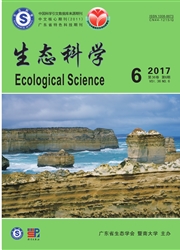

 中文摘要:
中文摘要:
采用批次培养的方法研究了邻苯二甲酸二丁酯(DBP)对绿色巴夫藻(Pavlova viridis)的生长毒性和干扰效应。实验设置了0 mg·L-1、2.5 mg·L-1、3.0 mg·L-1、3.5 mg·L-1、4.0 mg·L-1、5.0 mg·L-1和7.5 mg·L-1共7个质量浓度梯度的DBP暴露处理组,测定了绿色巴夫藻的细胞密度、光合色素含量、叶绿素荧光特性及丙二醛(MDA)含量等指标,试图揭示DBP对绿色巴夫藻的生态毒性影响规律及机制。结果表明:DBP暴露对绿色巴夫藻的生长具有显著抑制作用,高质量浓度(5.0 mg·L-1和7.5 mg·L-1)DBP暴露下绿色巴夫藻细胞10 d内全部死亡;随着DBP暴露质量浓度增加,藻细胞叶绿素a和类胡萝卜素含量均显著降低;DBP暴露使光系统Ⅱ(PSⅡ)的最大光能转化效率(Fv/Fm)、潜在光化学活性(Fv/Fo)、实际光能转化效率(Yield)和光合电子传递速率(ETR)等指标也显著降低;DBP暴露还能够使绿色巴夫藻的细胞MDA含量显著增加。该研究进一步证实了DBP污染物对微藻光系统和酶类生理生化过程的干扰作用。
 英文摘要:
英文摘要:
Toxicity and interference effects of dibutyl phthalate(DBP) on the growth of Pavlova viridis were studied. The exposure concentrations of DBP were 0,2.5,3.0,3.5,4.0,5.0,7.5 mg·L-1. The cell density,photosynthetic pigment content,chlorophyll fluorescence characteristics and malondialdehyde(MDA) content were examined. The results showed that DBP inhibited the growth of P.viridis,and the cells were completely killed at the high concentrations(5 and 7.5 mg·L-1). The contents of chlorophyll a and carotenoids significantly decreased with the increase of DBP concentrations. Photochemical efficiency of PSII(Fv/Fm),potential activity of PSII(Fv/Fo),actual photochemical efficiency of PSII in the light(Yield) and the electron transport rate(ETR) significantly decreased with increasing concentrations of DBP,while the content of MDA increased. The results confirm that the DBP has toxic effects on the population of the microalgae.
 同期刊论文项目
同期刊论文项目
 同项目期刊论文
同项目期刊论文
 Humic analog AQDS and AQS as an electron mediator can enhance chromate reduction by Bacillus sp stra
Humic analog AQDS and AQS as an electron mediator can enhance chromate reduction by Bacillus sp stra Compensatory growth of the bloom-forming dinoflagellate Prorocentrum donghaiense induced by nitrogen
Compensatory growth of the bloom-forming dinoflagellate Prorocentrum donghaiense induced by nitrogen Spatial and Seasonal Variations of Total Petroleum Hydrocarbonin Surface Water and Sediment in Pearl
Spatial and Seasonal Variations of Total Petroleum Hydrocarbonin Surface Water and Sediment in Pearl Promotion effects of nitrogen on the cell proliferation of Platymonas subcordiformis evaluated by sp
Promotion effects of nitrogen on the cell proliferation of Platymonas subcordiformis evaluated by sp Ecotoxicity of two organophosphate pesticides chlorpyrifos and dichlorvos on non-targeting cyanobact
Ecotoxicity of two organophosphate pesticides chlorpyrifos and dichlorvos on non-targeting cyanobact Ability of the marine diatoms Pseudo-nitzschia multiseries and P. pungens to inhibit the growth of c
Ability of the marine diatoms Pseudo-nitzschia multiseries and P. pungens to inhibit the growth of c Spatial–temporal distribution and potential ecological risk assessment of nonylphenol and octylpheno
Spatial–temporal distribution and potential ecological risk assessment of nonylphenol and octylpheno Spatial-temporal distribution of phthalate esters from riverine outlets of Pearl River Delta in Chin
Spatial-temporal distribution of phthalate esters from riverine outlets of Pearl River Delta in Chin Determination of enrofloxacin and ciprofloxacin in foods of animal origin by capillary electrophores
Determination of enrofloxacin and ciprofloxacin in foods of animal origin by capillary electrophores Distribution and Risk Assessment of Heavy Metals inSediments of the Pearl River Estuary, Southern Ch
Distribution and Risk Assessment of Heavy Metals inSediments of the Pearl River Estuary, Southern Ch Occurrence of phthalate esters in surface water and sediments from the Pearl River Delta, Southern C
Occurrence of phthalate esters in surface water and sediments from the Pearl River Delta, Southern C Growth effects on mixed culture of Dunaliella salina and Phaeodactylum tricornutum under different i
Growth effects on mixed culture of Dunaliella salina and Phaeodactylum tricornutum under different i Inhibitory effects of Chinese traditional herbs and herb-modified clays on the growth of harmful alg
Inhibitory effects of Chinese traditional herbs and herb-modified clays on the growth of harmful alg Allelopathic interactions between the red-tide causative dinoflagellate Prorocentrum donghaiense and
Allelopathic interactions between the red-tide causative dinoflagellate Prorocentrum donghaiense and Determination of Six Organophosphorus Pesticides in Water by Single-Drop Microextraction Coupled wit
Determination of Six Organophosphorus Pesticides in Water by Single-Drop Microextraction Coupled wit Effect of Vitamin-B1 and Vitamin-B12 on the Growth and Carotenoid Content of Haematococcus pluvialis
Effect of Vitamin-B1 and Vitamin-B12 on the Growth and Carotenoid Content of Haematococcus pluvialis 期刊信息
期刊信息
